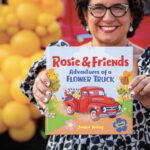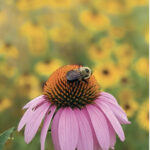 It is taking hold of us now. An invisible, primal, internal force.
It is taking hold of us now. An invisible, primal, internal force.
I need to get dirty.
I need to be outside.
I need to plant.
Funny how there are so many of us responding to the same stimulus. A 50-degree day is all it takes. We wake from our winter slumber energetically charged, the phenomenon known as “Spring Fever.”
So what to do with all this energy? Most of us run around all scattered and, in June, we look back and think, “What just happened?” I have discovered making a list of chores is a great way to get stuff done without being quite as distracted.
Paying attention to your tools is a great thing to do now before the chaos arrives. Working with good tools makes tasks easier and more pleasant. Pruning tools should be sharpened and lubricant sprayed in the moving parts. Use a Speedy Sharp, file or sharpening stone to return a nice cutting edge. Clean any caked soil off of shovels. Bright pink duct tape wrapped around handles helps when tools decide to play hide and seek.
A nice stroll through the garden with eyes wide open will remind you of all the tasks you didn’t get to last autumn. With notebook in hand, jot down directives. I never did finish the brick edging I was installing…nor did my compost get fully moved.
Mulch & Prune
Of course, there will be the added spring checklist—cutting down ornamental grasses, removing all the leaves that blew in after we were done raking, etc. A nice fresh edge on the landscape bed lines also keeps mulch out of lawn.
Mulching note: Mulch should never be more than 2 to 3 inches deep, especially around our trees. Mulch rings around trees that look like volcanos are very bad for growth. They prevent water from reaching the surface roots, cause roots to grow up into the “cone” thus creating more drought stress, cause roots to circle and strangle trunks while seeking water, and cause the bark to rot around the crown.
A proper mulch ring at the base of a tree should look like a large plate, with the high spot around the perimeter of the circle. Trees grow 80 percent faster with a proper mulch ring laid.
Not everything should be pruned! Many a flower bud gets trimmed off in early spring from overzealous clipping. Most hydrangeas and azaleas should not be pruned in early spring. Many clematis will also be stripped of future blooms when pruned at the wrong time. Summer blooming spirea, butterfly bushes and abelia respond well to a deep haircut.
If you aren’t sure, call your local experts—before you trim. If you aren’t sure what shrubs you have, trim little pieces off and bring them in for proper identification.
Rinse & Rant
Adding plants to the landscape is another wonderful job on the task list. Maybe some plants have become overgrown or aren’t very happy/healthy. Notice if it is a sunny or shady area. Decide what the perfect mature size should be. Is the area very dry or very wet? All these details add up to successfully choosing a plant.
The early bird gets the birdhouse! Check your birdhouses for old nests and clean them out. Give the birdbaths and birdfeeders a good scrubbing. Bleach, used at the disinfection ratio, works great for cleaning. Rinse well with clear water when done. Clean up all the shells collecting under the feeder and discard.
My writings don’t feel complete to me until I rant a lawn rant. The lawn and weed killer commercials are being paraded already in front of our wide eyes. “Commercial” also translates to “manipulation.” We have come to associate (be manipulated to) the perfect green lawn with the perfect neighborhood and the perfectly caring neighbor.
Personally, I don’t think spreading chemicals all over my property equates to being a good neighbor. Personally, I don’t wage war against dandelions. Personally, I don’t need a grass-only lawn to prove my belonging to my neighborhood. I keep a meadow. I take a pH and soil nutrient test every few years. I use this information to apply the proper amount of lime and fertilizer. I never ever kill “weeds” in my meadow with chemicals.
The number of visiting butterflies, bees and pollinators reinforce my decision to go natural. If you live in a newer development where the topsoil was stripped away leaving subsoil, you are really in for a struggle. Grass likes good soil. Repeated applications of chemicals are not going to give you better soil. Choose organic fertilizers to start the long process of rebuilding your soil. Do your soil tests, make choices for the soil to get the reward of better grass growth. Be informed, don’t be a sheep.
Happy Spring! May the fun begin!
Erica Shaffer is the nursery manager at Highland Gardens, 423 S. 18th St., Camp Hill. www.highlandgardens.org.





